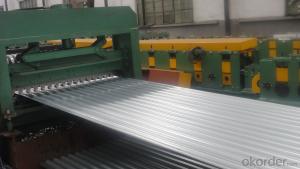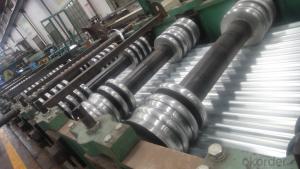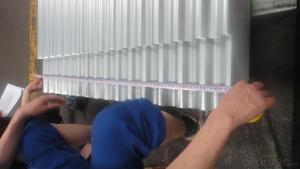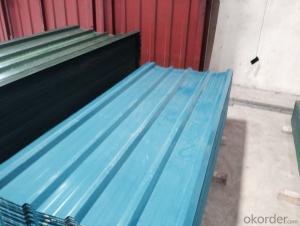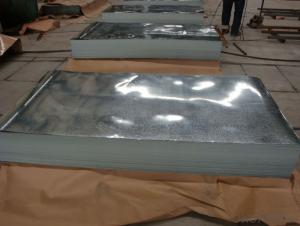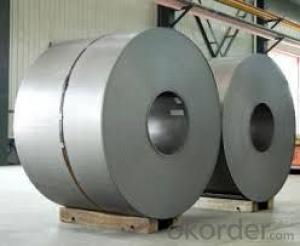0.12-1.2mm galvanized sheet price metal roofing material galvanized corrugated iron sheet
- Loading Port:
- Shanghai
- Payment Terms:
- TT OR LC
- Min Order Qty:
- 10 m.t.
- Supply Capability:
- 100000 m.t./month
OKorder Service Pledge
Quality Product, Order Online Tracking, Timely Delivery
OKorder Financial Service
Credit Rating, Credit Services, Credit Purchasing
You Might Also Like
0.12-1.2mm galvanized sheet price metal roofing material galvanized corrugated iron sheet
1> thickness: 0.12mm - 4.5mm
2> width:762mm/914mm/1200mm
3> length:Any length
4> basic material: Galvanized steel sheet, Aluzinc coated steel sheet, Aluminum steel sheet, Prepainted galvanized steel sheet, Prepainted aluzinc steel sheet
5> Zinc (Al) coating: 40g/m2 - 270g/m2
6> shape: corrugated/ trapezoid/Glazed
7> mainly usage: roof and wall
8> Package: standard export package or as customer's requirement
- Q:Can the steel sheets be easily drilled for fastening purposes?
- Drilling steel sheets for fastening purposes? Absolutely possible! Steel is renowned for its strength and durability, yet it remains relatively easy to work with when it comes to drilling. By employing the correct tools and techniques, you can effortlessly create holes in steel sheets to attach brackets, screws, or nails. Nevertheless, it's crucial to employ drill bits specifically designed for metal drilling. Moreover, during the drilling process, it might be necessary to utilize lubricants or cooling agents to prevent overheating and potential damage to the drill bit. Although drilling through steel sheets demands additional effort and careful handling, rest assured, it can be accomplished successfully for fastening purposes.
- Q:How do you prevent rusting on steel sheets?
- To prevent rusting on steel sheets, a few effective methods can be employed. Firstly, applying a protective coating such as paint, varnish, or a specialized rust-resistant primer can create a barrier between the steel and moisture, preventing rust formation. Additionally, keeping steel sheets dry and avoiding prolonged exposure to moisture, especially in humid environments, can significantly reduce the risk of rusting. Regularly inspecting and promptly addressing any scratches or damages on the steel surface by applying touch-up paint or protective sealants is also crucial in preventing rust from spreading. Finally, storing steel sheets in a dry and well-ventilated area can further minimize the chances of rust formation.
- Q:What are the different finishes available for steel sheets?
- Some of the different finishes available for steel sheets include hot rolled, cold rolled, galvanized, and coated finishes.
- Q:Are the steel sheets suitable for architectural cladding?
- Steel sheets are indeed appropriate for architectural cladding. Steel, being a sturdy and long-lasting substance, offers outstanding defense against weather conditions and external influences. It is easily malleable and can be crafted into diverse shapes, making it extremely adaptable for architectural purposes. Moreover, steel cladding provides a contemporary and polished appearance, permitting the creation of visually captivating building exteriors. Additionally, steel sheets can be coated or painted to augment their ability to resist corrosion and to further personalize their look. All in all, due to their strength, durability, versatility, and aesthetic allure, steel sheets are widely favored for architectural cladding.
- Q:Are steel sheets suitable for food-grade applications?
- No, steel sheets are generally not suitable for food-grade applications as they can potentially leach harmful substances into the food.
- Q:What is the weight of a standard steel sheet?
- The weight of a standard steel sheet can vary depending on its dimensions and thickness. However, a commonly used gauge is 20, which has a weight of approximately 9.81 pounds per square foot.
- Q:What is the difference between a galvanized and aluminized steel sheet?
- The durability and corrosion-resistant properties of galvanized steel and aluminized steel sheets make them widely used in various industries. However, there are notable distinctions between the two. Galvanized steel sheets have a layer of zinc coating that safeguards the underlying steel from rust and corrosion. This process, called galvanization, can be accomplished by immersing the steel sheet in a bath of molten zinc or by electroplating a zinc-rich coating. The zinc layer acts as a sacrificial barrier, meaning it will corrode before the steel, providing excellent rust protection. Galvanized steel finds common usage in outdoor applications like roofing, fences, and automobile parts. In contrast, aluminized steel sheets are coated with an aluminum-silicon alloy layer. This process, known as aluminization, involves immersing the steel sheet in a bath of molten aluminum or applying a thin layer of aluminum-silicon alloy through a continuous hot-dip process. The aluminum-silicon coating offers remarkable heat resistance and corrosion resistance. Aluminized steel is commonly employed in applications where high temperatures are present, such as automotive exhaust systems, heat exchangers, and ovens. To summarize, the primary distinction between galvanized and aluminized steel sheets lies in the type of coating applied to the steel. Galvanized steel is coated with zinc, providing outstanding rust protection, while aluminized steel is coated with an aluminum-silicon alloy, offering superior heat and corrosion resistance. The choice between the two depends on the specific requirements of the application, such as the presence of high temperatures or the need for long-lasting rust protection.
- Q:Can steel sheets be used for manufacturing electrical enclosures?
- Indeed, it is possible to utilize steel sheets in the production of electrical enclosures. The durability, strength, and capability of steel to provide essential safeguarding for electrical components have rendered it a widely employed material for constructing such enclosures. By employing steel sheets, one can ensure that the enclosure possesses robustness and can endure diverse environmental conditions. Furthermore, steel possesses commendable electromagnetic shielding properties, which aid in safeguarding delicate electronic equipment against interference. Additionally, steel sheets are resistant to fire, rendering them appropriate for manufacturing enclosures that must adhere to safety regulations. In summary, steel sheets are a dependable option for fabricating electrical enclosures due to their attributes and appropriateness for the intended purpose.
- Q:What is the average thermal conductivity of steel sheets?
- The average thermal conductivity of steel sheets can vary depending on various factors such as the specific type or grade of steel, its composition, and temperature. However, on average, the thermal conductivity of steel sheets ranges between 15 and 30 Watts per meter-kelvin (W/m·K). This means that steel sheets are relatively good conductors of heat, allowing them to efficiently transfer thermal energy across their surfaces. It is important to note that the actual thermal conductivity of a specific steel sheet can be determined through laboratory testing or by consulting technical specifications provided by the manufacturer.
- Q:What is the hardness of the steel sheets?
- The specific grade and treatment of steel can cause variations in the hardness of steel sheets. The Rockwell hardness scale is commonly used to measure the resistance of steel sheets to indentation. The hardness of steel sheets can vary greatly, ranging from soft to extremely hard, and is influenced by factors like carbon content, alloying elements, and heat treatment methods employed in manufacturing. When choosing steel sheets, it is crucial to consider the intended application and desired properties, as the hardness can impact wear resistance, strength, and machinability.
1. Manufacturer Overview |
|
|---|---|
| Location | |
| Year Established | |
| Annual Output Value | |
| Main Markets | |
| Company Certifications | |
2. Manufacturer Certificates |
|
|---|---|
| a) Certification Name | |
| Range | |
| Reference | |
| Validity Period | |
3. Manufacturer Capability |
|
|---|---|
| a)Trade Capacity | |
| Nearest Port | |
| Export Percentage | |
| No.of Employees in Trade Department | |
| Language Spoken: | |
| b)Factory Information | |
| Factory Size: | |
| No. of Production Lines | |
| Contract Manufacturing | |
| Product Price Range | |
Send your message to us
0.12-1.2mm galvanized sheet price metal roofing material galvanized corrugated iron sheet
- Loading Port:
- Shanghai
- Payment Terms:
- TT OR LC
- Min Order Qty:
- 10 m.t.
- Supply Capability:
- 100000 m.t./month
OKorder Service Pledge
Quality Product, Order Online Tracking, Timely Delivery
OKorder Financial Service
Credit Rating, Credit Services, Credit Purchasing
Similar products
New products
Hot products
Hot Searches
Related keywords

